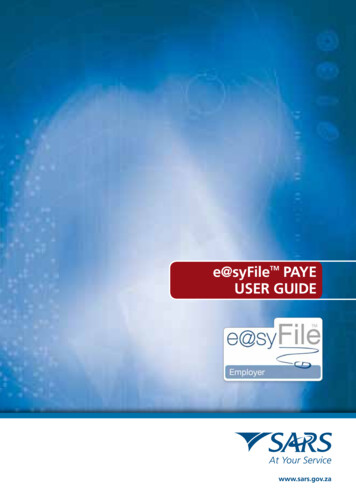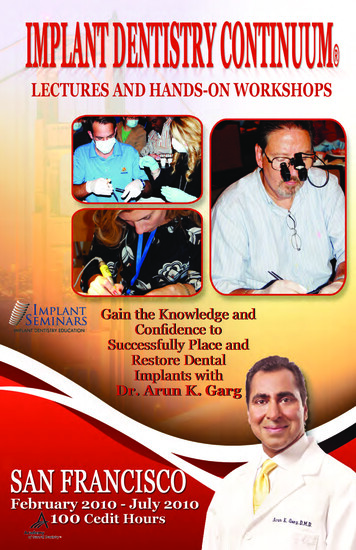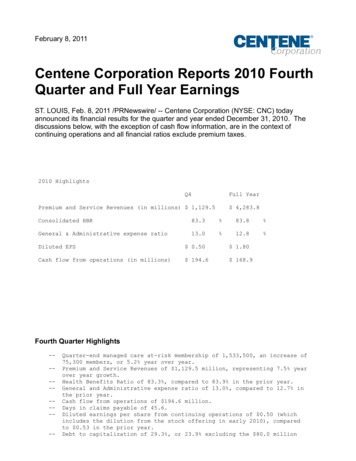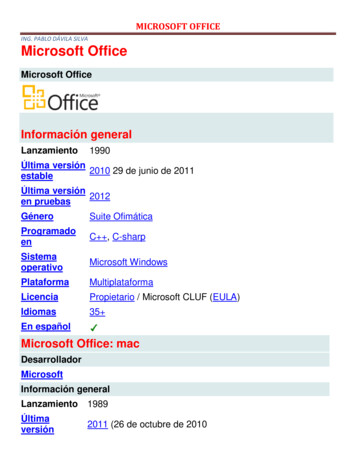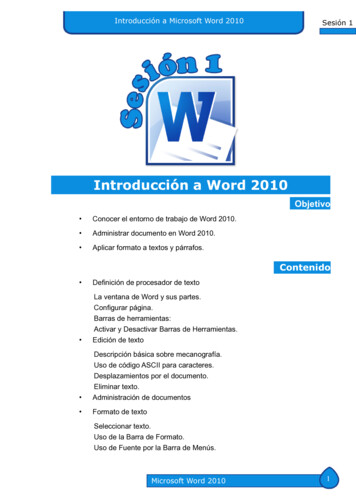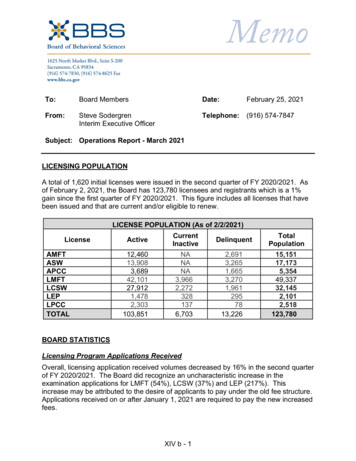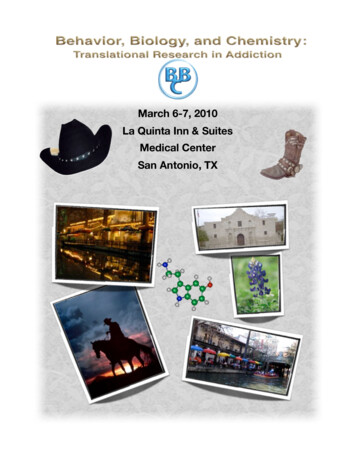
Transcription
March 6-7, 2010La Quinta Inn & SuitesMedical CenterSan Antonio, TX
AcknowledgementsSponsorsUniversity of Arkansas for Medical SciencesUniversity of Texas at San Antonio (Office of the Dean, College of Sciences)University of Texas Health Science Center at San Antonio (Center for Biomedical Research; Departments ofPharmacology, Physiology, and Psychiatry; Office of the Dean, Graduate School of Biomedical Sciences; Officeof the Dean, School of Medicine; Office of the Dean, School of Health Professions; Office of the President)University of Texas Medical Branch at Galveston (Department of Pharmacology & Toxicology and Center forAddiction Research)University of Texas El PasoUniversity of Maryland School of PharmacyLocal OrganizingCommitteeProgram CommitteeAwards CommitteeMarilyn E. CarrollEdward CastañedaWilliam P. ClarkeWilliam P. ClarkeSandra ComerCharles P. France*Wouter Koek*Lance McMahon*Richard LambAmy Hauck NewmanThomas PrisinzanoJoe MartinezLance McMahonWouter KoekTravel AwardeesNoelle AnastasioJustin AnkerBrandi BlaylockYukun ChenMatthew FrankSteven GravesMaria Velez HernandezMalliga IyerSean JonesDavid MatuskeyLuis NatividadSandra RokosikKatherine SmithAdam StewartOscar TorresTamara VasiljevikBermary Santos VeraEllen WalkerSession ChairsAdministrative SupportSandy ComerAndrew CoopChris CruzEmma CarreonWouter KoekAmy NewmanMargarita GardeaAnn HixThomas PrisinzanoJohn RoacheNatalina MartinezMarlys QuickGalen WengerSandra Westermanhttp://pharmacology.uthscsa.edu/bbc.asp* Committee Chairperson
Behavior, Biology, and Chemistry: Translational Research in Addiction2010Program OverviewFriday March 5, 20104:00 pm - 7:00 pmRegistration7:30 pm - 10:00 pmOpening Reception at Rio Rio on the San Antonio RiverwalkBuses depart from La Quinta at 7:00 PMSaturday March 6, 20107:00 am - 5:00 pmRegistration8:10 am - 8:15 amWelcome and Opening Remarks8:15 am - 10:35 amJunior Investigator Oral Communications (Chair: Galen Wenger)10:35 am - 11:00 amCoffee Break11:00 am - 12:10 amPlenary Symposium (Part I): “D3 Receptors and Addiction”Speakers: Amy Newman, Bruce Jenkins(Chairs: Amy Newman and Wouter Koek)12:15 pm - 1:45 pm1:45 pm - 2:55 pmLunchPlenary Symposium (Part II): “D3 Receptors and Addiction”Speakers: Robert Luedtke, Michael Nader(Chairs: Amy Newman and Wouter Koek)3:00 pm - 4:00 pmSpecial Lecture: Christian Heidbreder “Current perspectives on selective dopamine D3receptor antagonists as pharmacotherapeutics for addictions and relateddisorders” (Chair: Amy Newman)4:00 pm - 4:30 pmPoster set-up4:30 pm - 7:00 pmPoster Session7:00 pm - 9:00 pmDinnerAfter Dinner Speaker: R. Adron Harris; “Small molecule seeks protein partners formeaningful relationship” (Chair: John Roache)9:00 pm - 11:00 pmHospitality and EntertainmentSunday March 7, 20108:00 am - 9:40 amOpen Oral Communications I (Chair: Thomas Prisinzano)9:40 am - 9:55 amCoffee Break9:55 am - 11:15 amOpen Oral Communications II (Chair: Sandy Comer)11:15 am - 11:30 amCoffee Break11:30 am - 12:30 pmSpecial Lecture: F. Ivy Carroll “Development of selective kappa opioid receptorantagonists” (Chair: Andrew Coop)12:30 pm - 1:30 pmLunchPresentation of travel awards and awards for oral and poster presentationsClosing RemarksSee you at BBC 2011!
Behavior, Biology, and Chemistry: Translational Research in Addiction2010Program DetailsFriday March 5, 2010 (7:30 pm - 10:00 pm)Opening ReceptionRio RIo on the Riverwalk7:00 pmBuses depart from La Quinta7:30 pm - 10:00 pmReception at Rio Rio9:30 pmFirst bus departs for La Quinta10:00 pmLast bus departs for La QuintaCome and enjoy a fabulous evening on the beautiful San Antonio Riverwalk. Buses will depart from the La Quintahotel at 7:00 pm to take you to Rio Rio, a mexican restaurant on the Riverwalk. Buses will return to La Quinta at9:30 pm and 10:00 pm. You will need your badge to board the bus and for dinner. TIckets for spouses andsignificant others can be purchased at the registration desk for 60.00.Saturday March 6, 2010Welcome and Opening Remarks (8:10 am - 8:15 am)Junior Investigator Oral Communications (Chair: Galen Wenger)8:15 am - 8:35 amColin Cunningham, University of Texas Health Science Center at San AntonioBehavioral effects of nicotine and varenicline: differences in nicotine acetylcholinereceptor activation.8:35 am- 8:55 amBrandi Blaylock, Wake Forest University School of MedicineEffects of varenicline on the discriminative stimulus effects of nicotine in femalecynomolgus monkeys.8:55 am - 9:15 amLuis Natividad, University of Texas at El PasoThe rewarding effects of nicotine are enhanced in adolescent rats and adults thatwere pre-exposed to nicotine during adolescence.9:15 am - 9:35 amAmy Eppolito, University of Texas Health Science Center at San AntonioEffects of acute and chronic flunitrazepam on delay discounting in pigeons.9:35 am - 9:55 amAdam Stewart, Tulane University School of MedicineRepeated drug withdrawal paradigm in zebrafish, Danio rerio.9:55 am - 10:15 amMichelle Baladi, University of Texas Health Science Center, San AntonioEating a high fat chow increases the sensitivity of rats to some behavioral effects ofquinpirole.10:15 am - 10:35 amGregory Collins, University of MichiganResponse-maintaining effects of D2-like agonists in rats: Influence of operant historyand conditioned reinforcement.Coffee Break (10:35 am - 11:00 am)
Behavior, Biology, and Chemistry: Translational Research in Addiction2010Saturday March 6, 2010 (continued)Plenary Symposium (Chair: Amy Newman, Wouter Koek)Dopamine D3 Receptors and AddictionIt is well documented that the mesolimbic DA system, and especially D1 and D2 receptors, is critically involved indrug reward and addiction. With the recent discovery of D3 receptors, a growing body of evidence stronglysuggests that the D3 receptor is involved in addiction. There is now a critical need to understand the role of D3receptor systems in the mechanisms of drug dependence and abuse and for development of new drugs as toolsto study D3 receptor systems. This symposium will explore some of the recent data on D3 receptor localizationand function in brain and discuss novel actions of drugs at D3 receptors.Part I11:00 pm - 11:35 amAmy H. Newman; National Institute on Drug Abuse, Medicinal Chemistry SectionEvolution of D3 receptor antagonists and partial agonists11:35 am - 12:10 pmBruce Jenkins; Harvard Medical School/Massachusetts General HospitalphMRI of D3 receptors in rodents and primatesLunch (12:15 pm - 1:45 pm)Plenary Symposium (Chair: Amy Newman, Wouter Koek)Dopamine D3 Receptors and AddictionPart II1:45 pm - 2:20 pmRobert R. Luedtke; University of North Texas Health Science CenterFunctional selectivity of D3 dopamine receptor-selective ligands2:20 pm - 2:55 pmMichael A. Nader; Wake Forest UniversityInteractions of cocaine history with the behavioral effects of D3 compounds innonhuman primatesSpecial Lecture 3:00 pm - 4:00 pm (Chair: Amy Newman)Christian Heidbreder: “Current perspectives on selective dopamine D3receptor antagonists as pharmacotherapeutics for addictions andrelated disorders”Reckitt Benckiser Pharmaceuticals
Behavior, Biology, and Chemistry: Translational Research in Addiction2010Saturday March 6, 2010 (continued)Poster Set-up (4:00 pm - 4:30 pm)Poster Session (4:30 pm - 7:00 pm)4:30 pm - 5:30 pm Odd numbered posters should be manned by their presenters.5:30 pm - 6:30 pm Even numbered posters should be manned by their presenters.Poster Awards: The Awards Committee will hear oral poster presentations ( 10 min) from undergraduate,graduate students, and post-doctoral fellows. One award will be made to the best undergraduate/graduate student poster presentation and one award for the best post-doctoral fellow posterpresentation will be made.Poster judging (for postdoctoral fellows and graduate students) will begin at 4:30 pm or 5:30 pm for oddand even numbered posters, respectively. Judges will begin with the lowest numbered posters andproceed to the higher numbered posters. Separate groups of judges will judge postdoctoral postersand graduate student posters.If you do not wish to be included in the poster competition, please notify us at the registration table.Dinner (7:00 pm - 9:00 pm)After Dinner Lecture (Chair: John Roache)R. Adron Harris: “Small molecule seeks protein partners formeaningful relationship”University of Texas at AustinHospitality and Entertainment (9:00 pm - 11:00 pm)Live music will be provided by the Tennessee Valley Authority (TVA). Come and enjoy the fun! In the ballroom atLa Quinta.
Behavior, Biology, and Chemistry: Translational Research in Addiction2010Sunday March 7, 2010Oral Communications I (Chair: Thomas Prisinzano)8:00 am - 8:20 amOscar Torres, University of Texas at El PasoNicotine withdrawal enhances anxiety-like behavior in female versus male rats.8:20 am - 8:40 amJonathan Pinkston, University of Texas Health Science Center at San AntonioAdolescent-limited and life-persistent impulsive choice: studies with inbred mice.8:40 am - 9:00 amAndrew Coop, University of MarylandPhenylpropyloxyethylamines – a new class of opioids?9:00 am - 9:20 amMartin Javors, University of Texas Health Science Center, San AntonioCombination of breath carbon monoxide and saliva cotinine levels to estimate smoking.9:20 am - 9:40 amMalliga Iyer, National Institutes of HealthStudies on racemic cis-benzofuro[2,3-c]pyridin-6-ols and cis-benzofuro[2,3-c]pyridin8-ols: Probes for narcotic receptor mediated phenomena.Coffee Break (9:40 am - 9:55 am)Oral Communications II (Chair: Sandy Comer)9:55 am - 10:15 amLaura O’Dell, The University of Texas at El PasoA psychobiological framework of the substrates that mediate enhanced tobacco abuseduring adolescence.10:15 am - 10:35 amBarry Setlow, Texas A&M UniversityDopaminergic modulation of risky decision-making.10:35 am - 10:55 amAllan Kalueff, Tulane University School of MedicineZebrafish behavioral and endocrine responses to drugs of abuse: LSD, MDMA,morphine, pentobarbital and benzodiazepines.10:55 am - 11:15 amClaudia Miller, University of Texas Health Science Center at San AntonioDo environmental exposures initiate and exacerbate addiction?Coffee Break (11:15 am - 11:30 am)Special Lecture 11:30 am - 12:30 pm (Chair: Andrew Coop)F. Ivy Carroll: “Development of selective kappa opioid receptorantagonists”Research Triangle InstituteLunch (12:30 pm - 1:30 pm)Presentation of awards for travel, oral, and poster presentationsClosing Remarks and AdjournmentSee you at BBC 2011!
Behavior, Biology, and Chemistry: Translational Research in Addiction2010AbstractsOral Communications12Behavioral effects of nicotine and varenicline: differences in nicotineacetylcholine receptor activation.Cunningham, Colin1; McMahon, Lance R11Department of Pharmacology, UTHSCSA, San Antonio, TX USAEffects of varenicline on the discriminative stimulus effects of nicotine infemale cynomolgus monkeys.Brandi L. Blaylock1, Susan H. Nader1, Michael A. Nader1,2Department of Physiology and Pharmacology1, Department of Radiology2Wake Forest University School of Medicine, Winston-Salem, North CarolinaVarenicline (Chantix ) is a recently approved pharmacotherapy that is reported to be more effective than nicotine in promoting smoking cessation.Pharmacologic mechanisms responsible for differences in clinical effectivenessare not well established. To examine differences in site of action and efficacyat nicotine acetylcholine receptors that could underlie differences in clinicaleffectiveness, nicotine and varenicline were compared in two behavioral assaysin C57BL/6J mice. In mice responding under a fixed ratio 30 schedule of milkdelivery, nicotine and varenicline dose-dependently reduced responding; nicotine was more potent than varenicline. The non-selective, non-competitivenicotine acetylcholine antagonist mecamylamine attenuated the effects ofnicotine and varenicline to decrease responding, indicating that both drugsacted through mecamylamine (i.e. nicotine acetylcholine) sensitive receptors.In mice discriminating a relatively large dose (1.78 mg/kg s.c.) of nicotinefrom saline, nicotine and varenicline dose-dependently increased nicotineappropriate responding; nicotine was again more potent than varenicline.There was striking consistency in the potency of nicotine to increase nicotineappropriate responding among mice, whereas varenicline produced maximalincreases in nicotine-appropriate responding at different doses among mice.When combined with nicotine, varenicline produced a leftward shift in thenicotine dose-response curve for not only discriminative stimulus effects, butalso the effects of nicotine to decrease response rate. Collectively, these resultssuggest that varenicline acts through nicotine receptors to produce behavioraleffects; however, differences in the pattern of discriminative stimulus effectsamong animals suggest that nicotine and varenicline diverge in their receptormechanisms. Under the present experimental conditions, it appears that varenicline does not have lower nicotine agonist efficacy than nicotine. Alternatively, nicotine and varenicline could differ in their selectivity for nicotinereceptor subtypes. Funded by USPHS grant DA25267.Nicotine (NIC) is a widely abused drug, primarily consumed through tobaccoproducts. Varenicline (VAR), a nicotinic acetylcholine receptor partial agonist,is an FDA-approved pharmacotherapy for smoking cessation. Despite itsclinical use, little preclinical research exists to understand how VAR reducesthe abuse liability of NIC. Rodent studies have demonstrated that the nicotinicB2 subunit mediates dopamine release caused by NIC (Grady et al. 2001),which may also contribute to its’ discriminative stimulus (Di Chiara and Imperato 1988, Corrigall et all 1994). VAR is a partial agonist at a4B2 nicotinicreceptors. In rodent studies, VAR has been shown to decrease the reinforcingeffects of NIC and fully (Rollema et al., 2007) or partially substitute (Ross etal., 2009) for nicotine. However, there are no published studies in nonhumanprimates examining the effects of VAR on the discriminative stimulus effectsof NIC. We investigated the effects of VAR (0.03-0.3 mg/kg, base) alone atseveral pretreatment times (10-120 min) and in combination with NIC (0.1-0.3mg/kg, base) in a two-choice, food-reinforced, drug discrimination procedurein which ovariectomized female cynomolgus monkeys (n 4) were trained todiscriminate 0.3 mg/kg NIC from saline (i.m., 10-min presession). Preliminarydata suggest that VAR does not engender NIC-like discriminative stimuluseffects, at any dose or pretreatment time, although it can have effects on response rates. Time course studies suggest that when administered 10 min and60 min prior to NIC, VAR abolished responding and elicited emesis. Whenadministered 120 min prior to the training dose of NIC, VAR (0.1-0.3 mg/kg)blocked the NIC-like discriminative stimulus effects without affecting responserates. These results suggest VAR synergistically interacts with NIC at earlytime points to potentiate the rate-decreasing effects of NIC, but antagonizes thediscriminative stimulus effects of NIC at later time points. DA1246034The rewarding effects of nicotine are enhanced in adolescent rats andadults that were pre-exposed to nicotine during adolescence.Natividad, Luis A., Torres, Oscar V., Escalante, Evelyn, O’Dell, Laura E.Department of Psychology, University of Texas at El PasoEffects of acute and chronic flunitrazepam on delay discounting in pigeons.Eppolito, Amy K.1; France, Charles P.1,2; Gerak, Lisa R.1Departments of Pharmacology1 and Psychiatry2, University of Texas HealthScience Center at San Antonio, San Antonio, TX, USA.Much work has shown that adolescence is a unique period of developmentcharacterized by enhanced tobacco abuse that facilitates long-term susceptibility to tobacco dependence in adulthood. The goal of this study was to comparethe rewarding effects of nicotine in adolescent and adult animals, and to determine whether exposure to nicotine during adolescence produces long-lastingchanges in the rewarding effects of nicotine in adulthood. We used anextended-access model of nicotine self-administration (SA) whereby rats weregiven 23-hour access to increasing doses of nicotine separated by brief periodsof nicotine abstinence. This model allowed us to compare nicotine intake in ourtreatment conditions across a range of nicotine doses and following repeatednicotine withdrawal. Adolescent and adult rats were implanted with a jugularcatheter for nicotine SA. An additional group of adolescents were implantedwith a subcutaneous pump that delivered nicotine for 14 days (4.2 mg/kg/day;base), and they received jugular catheters later in adulthood. All rats weregiven access to nicotine SA for 3 separate cycles that lasted 4 days, and duringeach cycle, rats received a higher dose of nicotine as follows: 0.03, 0.06, and0.09 mg/kg (base)/0.1 ml infusion. Each 4-day cycle was separated by a forcedperiod of abstinence where the rats were returned to their home cages for 3days. Our results revealed that adolescents displayed higher nicotine intakerelative to both adult groups. Also, pre-exposed adults displayed higher nicotine intake relative to adult rats that were not pre-exposed to nicotine duringadolescence. Lastly, all groups of animals displayed enhanced responding fornicotine following each of the forced abstinence periods, and this effect wasalso higher in adolescent and pre-exposed adult animals. Taken together, ourfindings suggest that enhanced rewarding effects of nicotine during the adolescent period of development contribute to long-term vulnerability to tobaccodependence. This research was supported by the National Institute on DrugAbuse Grants (R01DA021274; LEO and F31DA021133; LAN) and the American Psychological Association- Diversity Program in Neuroscience(T32MH018882-20; LAN).Drug abusers tend to be more impulsive than nonusers on a variety of measuresand there is growing evidence that impulsivity both contributes to and is aconsequence of addiction. One aspect of impulsivity can be studied with delaydiscounting procedures in which subjects choose between an immediatelyavailable small reinforcer and a delayed larger reinforcer. Benzodiazepines arecommonly abused especially in combination with illicit drugs; little is knownabout the effects of chronic benzodiazepine use on delay discounting. In thisstudy, adult white Carneaux pigeons (n 6) responded for food in a delay discounting procedure in which delays were increased across the session comprising five 16-min cycles. On the first cycle no delays were imposed; beginningon the second cycle, a delay to the large reinforcer was introduced and thereafter doubled with each cycle. Pigeons responded predominantly for the largereinforcer (4.5 sec access to food) when there was no delay and switchedresponding to predominantly the small reinforcer (1 sec access) as the delay tothe large reinforcer increased. Acute administration of the benzodiazepineflunitrazepam (0.32, 1.0 and 3.2 mg/kg) increased choice for the large reinforcer in spite of increasing delays; at the longest delay, 70% of responses werefor the large reinforcer. Daily treatment with flunitrazepam resulted in tolerance to this effect such that, at the longest delay, the percent of responses forthe large reinforcer decreased to 36%. When daily treatment ended, responding for the large reinforcer returned to control (15% of responses for the largereinforcer). Given that pigeons respond more for delayed reinforcers whentreated with flunitrazepam, these data suggest that benzodiazepines might beeffective in reducing impulsive behaviors. Because drug abusers discountdelayed rewards more rapidly than nonusers, understanding how chronic druguse and withdrawal affect choice behavior could lead to improved treatmentsfor addiction.
Behavior, Biology, and Chemistry: Translational Research in Addiction2010Oral Communications56Repeated drug withdrawal paradigm in zebrafish, Danio rerioStewart, Adam; Cachat, Jonathan; Goodspeed, Jason; Suciu, Chris; Roy, Sudipta; Wong, Keith; Gaikwad, Siddharth; Chung, Kyung Min; Elegante,Marco; Bartels, Brett; Elkhayat, Salem; Tien, David; Tan, Julia; Grimes, Chelsea; Denmark, Ashley; Gilder, Tom; Beeson, Esther; Wu, Nadine; DiLeo, John;Grossman, Leah; Frank, Kevin; Kalueff, Allan V.Department of Pharmacology and Neuroscience Program, Tulane UniversitySchool of Medicine, New Orleans, LA, USAEating a high fat chow increases the sensitivity of rats to some behavioraleffects of quinpiroleBaladi, Michelle G1 and France, Charles P1,2Departments of Pharmacology1 and Psychiatry2, University of Texas HealthScience Center, San Antonio, TX, USAZebrafish are emerging as a reliable and high-throughput animal model inneurobehavioral research. Recent studies suggest the potential of zebrafish asa model for drug reward and addiction. With their robust phenotypes, they arewell suited for behavioral analysis in addiction and withdrawal research. Onesuch method of behavioral analysis is the novel tank diving paradigm, whichwe used to explore zebrafish behavior in response to a series of repeated withdrawal experiments utilizing different pharmacological agents. After 1 week ofchronic treatment, fish were placed into exposure tanks with fresh untreatedwater for 3 h at a time, twice per day for 1 week prior to testing. Our resultsshow that repeated morphine and ethanol withdrawal induced a significantelevation in anxiety-related behaviors. The treated groups experienced a strongdecrease in exploratory behavior (longer latency to, transitions to, and durationin the top of the tank), prolonged freezing, and increased erratic movements.These results are also of clinical relevance, especially in regards to alcoholismas it is a cyclical disease characterized by recurring periods of withdrawal andexposure. Our study further validates the merit of zebrafish in neurobehavioralresearch and reconfirms their utility for modeling drug withdrawal syndrome.Many drugs of abuse as well as drugs used clinically target dopamine systemsand act either indirectly or directly at dopamine receptors. Dopamine D2 andD3 receptors are important drug targets and recent studies suggest that changesin food intake can markedly affect the behavioral effects of drugs acting atthese receptors (e.g. quinpirole). The current study examined the impact offeeding condition on sensitivity to behavioral effects of quinpirole in rats withaccess to either a standard (5.7 % fat) or a high fat (34.3%) chow. When ratshad access to a high fat chow, the quinpirole discrimination dose-responsecurve (mediated by D3 receptors) shifted leftward. In the same rats, both theascending (mediated by D3 receptors) and descending (mediated by D2 receptors) limbs of the dose-response curve for quinpirole-induced yawning shiftedleftward. These results indicate that access to a high fat chow increases sensitivity of both D2 and D3 receptors and furthermore suggests that eating highfat food might impact the clinical or abuse-related effects of drugs acting ondopamine systems.78Response-Maintaining Effects of D2-like Agonists in Rats: Influence ofOperant History and Conditioned Reinforcement.Collins, Gregory T and Woods, James HDepartment of Pharmacology, University of Michigan, Ann Arbor, MI, 48019Nicotine withdrawal enhances anxiety-like behavior in female versus malerats.Torres, Oscar V., Natividad, Luis A., Walker, Ellen M., Muñiz, Adrian K., andO'Dell, Laura E.University of Texas at El Paso, Department of Psychology, El Paso, Texas79968D2-like agonists, such as quinpirole (QPRL), maintain responding in rats andmonkeys, but are rarely abused in humans. The following studies were aimedat further elucidating the antecedents of QPRL-maintained responding in therat, and examined the influence of operant history and conditioned reinforcement (cocaine-paired stimuli; CS) on the capacity of QPRL to maintain and/orinduce responding. To determine whether rats would acquire a new responsefor QPRL rats were first trained to nosepoke for cocaine with substitutions ofQPRL, cocaine, remifentanil, nicotine, or saline performed on a previouslyinactive lever and paired with a novel stimuli; nosepokes continued to result inCS presentation. Despite the rapid reallocation of responding from the nosepoke to the lever when cocaine or remifentanil were available, lever pressesremained low, and nosepoking persisted when QPRL or nicotine were madecontingent upon lever presses. To evaluate the influence of CS on the capacityof QPRL to maintain responding, substitutions were performed in the presence,or absence of injection-CS pairings. Although cocaine maintained similar ratesof responding regardless of whether injections were accompanied by CS presentation, high rates of QPRL-maintained responding were only observed whenCSs were paired with injections. Finally, to evaluate whether the responsecontingent delivery of QPRL was necessary for QPRL to maintain responding,rats were pretreated with QPRL, cocaine, or saline and allowed to respond forthe stimuli that were previously paired with either cocaine or food delivery.Similar to when QPRL was substituted for cocaine, pretreatment with QPRLresulted in dose-dependent increases in responding that were dependent uponCS presentation. Together these results suggest that the response-maintainingeffects of QPRL are primarily mediated by a QPRL-induced enhancement ofthe conditioned reinforcing effects of previously cocaine-paired stimuli, andnot a primary reinforcing effect of QPRL.Clinical reports have shown that during abstinence, female smokers displaynegative mood states, such as depression, anxiety, and craving that is higherrelative to men. These negative mood states are believed to contribute to relapse behavior, and the possibility exists that intense stress produced by nicotine withdrawal may contribute to enhanced vulnerability to tobacco abuse infemale versus male smokers. To address this issue, the present study comparedanxiety-like behavior and plasma corticosterone levels (a blood maker of stressaxis activation) in male and female adult rats experiencing nicotine withdrawal.To examine potential sex differences in nicotine metabolism, we also comparedcotinine levels (a nicotine metabolite) in these animals. Rats were preparedwith subcutaneous pumps that delivered either saline or nicotine (4.7 mg/kg/day). After 14 days of nicotine exposure, the pumps were removed to inducespontaneous withdrawal. Twenty-four hours later, anxiety-like behavior wasassessed using elevated plus maze procedures. Immediately after behavioraltesting, blood samples were collected and analyzed for corticosterone andcotinine levels using radio-immune assay procedures. Our results revealed thatwithdrawal produced a significant increase in anxiety-like behavior and plasmacorticosterone levels in female rats experiencing withdrawal. However, theseeffects were reduced in male rats experiencing nicotine withdrawal. Thesebehavioral findings do not appear to be related to sex differences in nicotinemetabolism, since male and female rats displayed similar cotinine levels duringnicotine withdrawal. Taken together, our data suggest that intense anxietyproduced by withdrawal may contribute to enhanced susceptibility to tobaccoabuse in female versus male smokers. Supported by the National Institute ofDrug Abuse Grant R01DA021274.
Behavior, Biology, and Chemistry: Translational Research in Addiction2010Oral Communications910Adolescent-limited and life-persistent impulsive choice: studies withinbred mice.Pinkston, JW, & Lamb, RJ1Department of Psychiatry, University of Texas Health Science Center at SanAntonio, San Antonio, TX, 2Department of Pharmacology, University ofTexas Health Science Center at San AntonioPhenylpropyloxyethylamines – a new class of opioids?Andrew CoopUniversity of MarylandImpulsive choice reflects the preference for smaller, immediate rewards overlarger, delayed rewards. In humans, impulsive choice is associated with increased risk of drug abuse, risky sexual practices, and other deviant behavior.In humans, impulsive choice generally peaks during adolescence and declinesby middle adulthood. Developmental changes in impulsivity, however, havereceived little attention in the laboratory. In the present experiment, we explore a novel procedure for evaluating developmental changes in impulsivechoice using a rapid discounting task. The discounting task consisted of twophases. In the first phase, mice could choose between a 0.02-ml drop of milkor a 0.1-ml drop of milk, each delivered after a 1-s delay. After 7 sessions, thesecond phase began. Across days, the delay to the large drop of milk increasedfrom 1 to 100 s. Mice from two inbred strains, C57/BL6J and DBA/J2, werestudied on the discounting task at 6 and 12 weeks of age, corresponding toadolescent and adulthood, using a between-groups design. At the end of thefirst phase, mice of both ages showed a preference for the large reward. As thedelay to the large volume of milk increased, preference shifted to the smaller,immediate volume for all mice. How fast the function shifted, however, differed among strains and age groups. Adolescent mice of both strains showedsimilar shifts in preference, but adult mice showed differences in their responses to increasing delay. Specifically, adult DBA mice revealed a functionsimilar to adolescent mice of both strains, but C57 mice were less sensitive toincreases in delay (less impulsive) than adolescent mice or adult DBA mice.The results show that C57 mice show normative developmental changes inimpulsive choice similar to what has been reported in humans, i.e., impulsivein adolescence but not in adulthood. Interestingly, DBA make more impulsivechoices across development. The patterns shown by DBA mice may reflect“life-persistent” impulsivity reported in a subpopulation of humans. Implications for understanding impulse con
7:30 pm - 10:00 pm Opening Reception at Rio Rio on the San Antonio Riverwalk Buses depart from La Quinta at 7:00 PM Saturday March 6, 2010 7:00 am - 5:00 pm Registration 8:10 am - 8:15 am Welcome and Opening Remarks 8:15 am - 10:35 am Junior Investigator Oral Communications (Chair: Galen Wenger) 10:35 am - 11:00 am Coffee Break



